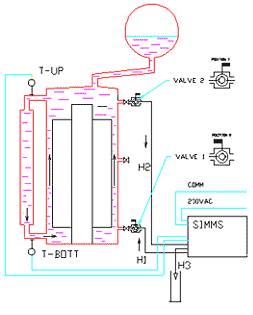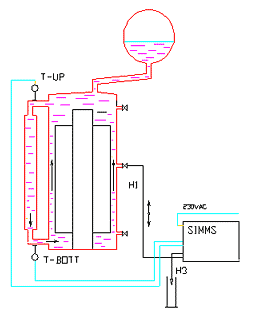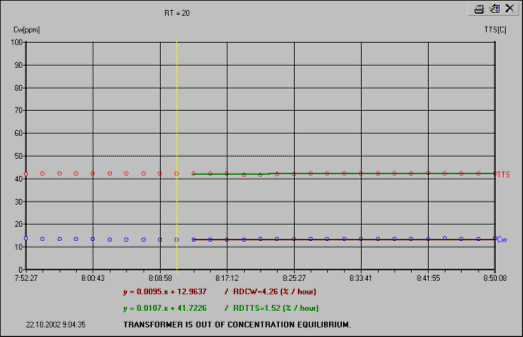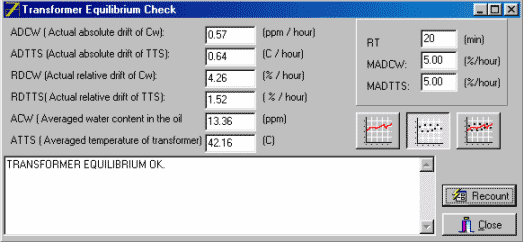SIMMS
SIMMS: Technical Specifications
One oil sample a year collected in a glass bottle or syringe, processed in a lab, with a high degree of variability due to the process and lack of controls, does not provide the degree of data and accuracy necessary for the competent failure risk management and for managing the appropriate insulation treatment program of the transformer.
SIMMS is basically used for two diagnostic procedures of transformer:
SIMMS - 2P (two point connection)

SIMMS -2P is connected to two oil sample taps, one at the top one at the bottom. Then, both connecting hoses are evacuated to avoid contamination by air-moisture. The oil is then drawn continuously through the SIMMS unit and passed back to the transformer. Independent temperature sensors are fitted to the designated top and bottom positions. Once SIMMS-2P is installed, connected and started (30 minutes), the transformer´s top (T-UP) and bottom temperatures (T-BOTT) and water content in the oil Cw (ppm) are recorded in a time-based log. Within 40 minutes an accurate snapshot decision info - if the adequate equilibrium is reached or not - is obtained (See Transformer equilibrium check)...
That allows precise accuracy in determining water levels in the solid insulation, and the temperature related movement and time lag of the water movement between the paper and the oil. The dielectric strength and load risk at peak load can be determined more accurately. While online, the data can be accessed directly by lap-top or remotely on your PC via an analogue phone (or GSM) connection, the graphs of trends produced, and saved as a file.
SIMMS - 1P (single point oil connection)

SIMMS - 1P is connected to one central oil access point, midway up the main tank. Having evacuated the c. hose SIMMS periodically draws the oil sample down, analyses it and returns it to the transformer. These steps clear the lines and ensure that the sample always represents the pattern of oil inventory. It is highly convenient for smaller transformers, or larger transformers with the oil sample access to be directly connected to the oil in the main tank without internal piping. Temperature sensors are connected to the bottom and top sleeves connecting the main tank with radiators allowing an average temperature to be established. Alternatively it can be connected to the top or bottom oil points, with care taken of the analysis on the "average" level of the water content in the oil inventory.
SIMMS -1P can be used for quick online snapshots of water in the oil and temperature profiles.
Transformer Equilibrium Check
The first and basic question to ask after the measurement is:
are the adequate equilibrium conditions (relatively constant temperature TTS and water content in oil Cw) in the transformer reached or not.
This evaluation is made (after the measurement by SIMMS is finished) by a lap-top connected by cable to the SIMMS.
If yes - all necessary calculations ( water content Cp, Temperature Loading Curve - TLC …) can be made immediately by the lap-top or from remote (and TRACONAL Program).
If no - the on-line measurement for a twenty-four hour period (or a complete load cycle period) is usually necessary. That allows to reach the desired accuracy in determining water levels in the solid insulation, and the temperature related movement and time lag of the water movement between the paper and the oil.
The dielectric strength and load risk at peak load can be immediately and accurately estimated and/or determined.
The SIMMS data can be basically accessed:
- directly and immediately by lap-top
- remotely on your PC via an analogue phone or GSM connection
In both cases the graphs of trends and results are saved as a file in the lap-top.
Yet, for a proper and precise quantitative time-log analysis - this technique is totally unsuitable. Thus, the linear regression for both time trends Cw = Cw(t) and TTS = TTS(t) constitutes the most effective method.
The procedure is started by clicking on the icon 

and we get Transformer Equilibrium Check

- All measured data can be properly named and sent to Archive by clicking on

- or sent to the clipboard for reprocessing

- or can be re-opened by clicking on
 and evaluated under different MAD-limits.
and evaluated under different MAD-limits.
From ACW (ppm) and ATTS (C) value accurate water removal treatment plans can be established using TRACONAL.
